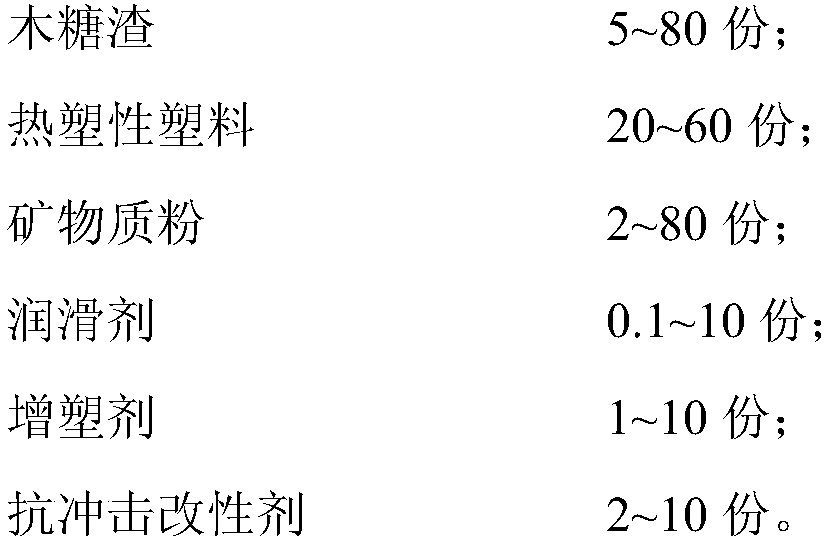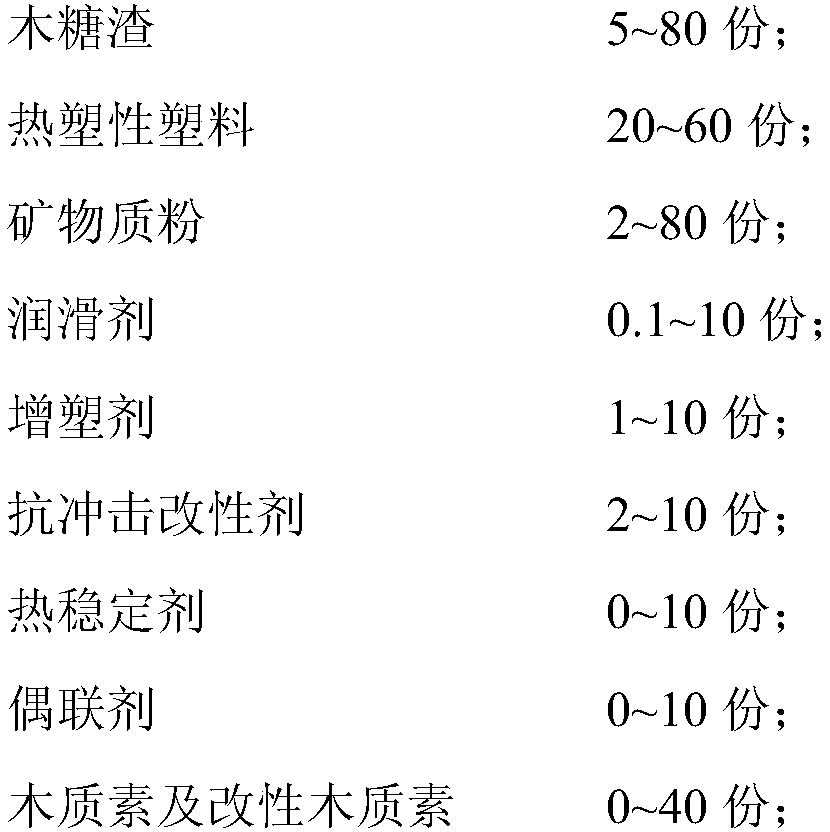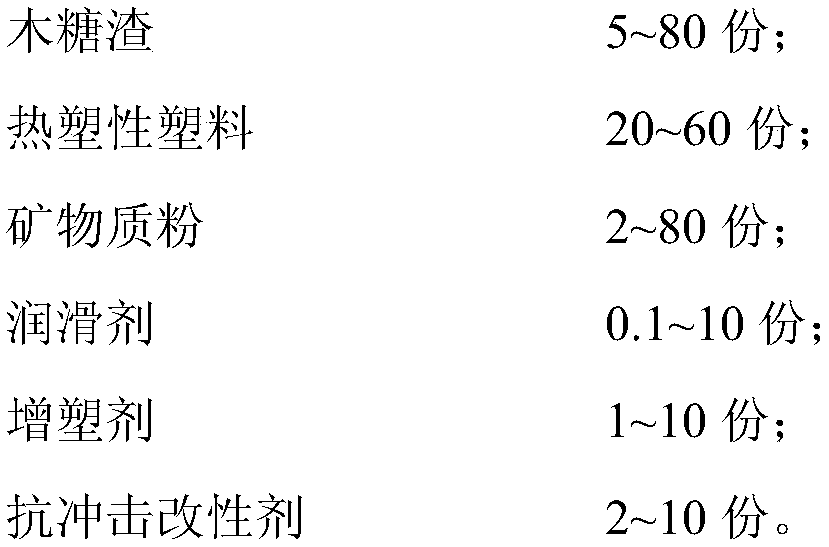Application of xylose residue in preparation of wood plastic material
A technology of wood-plastic materials and xylose slag, applied in the field of composite materials, can solve the problem of insufficient utilization of xylose slag
- Summary
- Abstract
- Description
- Claims
- Application Information
AI Technical Summary
Problems solved by technology
Method used
Image
Examples
Embodiment 1
[0096] Raw materials: 20 parts of dried xylose residue (300 mesh), 50 parts of polyethylene, 25 parts of nanometer calcium carbonate, 0.7 part of calcium stearate, 0.8 part of polyethylene wax, 2 parts of dioctyl phthalate, 8 acrylate copolymer.
[0097] The manufacturing method includes the following processes:
[0098] (1) Mix raw materials. Mixing is divided into two stages: hot mixing and cold mixing. First, heat mixing. According to the proportion, add each raw material to a high-speed mixer and mix at high speed (800rpm) until the temperature reaches 120°C, and then mix at a low speed (200rpm). When the temperature is lower than 90°C, the material is discharged;
[0099] (2) Make raw material granules, put the mixed raw materials into a twin-screw extrusion granulator for granulation;
[0100] (3) Extrude the profile, add the prepared raw material pellets into the single-screw extruder, and a mold with a specific shape is installed at the outlet of the screw mouth. The...
Embodiment 2
[0102] Raw materials: 15 parts of dried xylose residue (80 mesh), 3 parts of enzymatic lignin, 50 parts of polyethylene, 25 parts of glass fiber, 0.5 part of calcium stearate, 0.7 part of liquid paraffin, 5 parts of phthalic acid Dioctyl ester, 6 parts chlorinated polyethylene CPE
[0103] The manufacturing method includes the following processes:
[0104] (1) Mix raw materials. Mixing is divided into two stages: hot mixing and cold mixing. First, heat mixing. According to the proportion, add each raw material to a high-speed mixer and mix at high speed (800rpm) until the temperature reaches 120°C, and then mix at a low speed (200rpm). When the temperature is lower than 90°C, the material is discharged;
[0105] (2) Extrude the profile, add the mixed material into the parallel twin-screw extruder, and a mold with a specific shape is installed at the outlet of the screw mouth. The material is in a molten state under high temperature and high pressure, and enters from the entra...
Embodiment 3
[0107] Raw materials: 55 parts of dried xylose residue (100 mesh), 5 parts of lignosulfonate, 60 parts of polypropylene, 30 parts of asbestos fiber, 2 parts of zinc stearate, 3 parts of polyethylene wax, 10 parts of Malay Anhydride grafted polypropylene, 3 parts chlorinated paraffin, 2 parts ethylene-vinyl acetate copolymer
[0108] The manufacturing method includes the following processes:
[0109] (1) Mix raw materials. Mixing is divided into two stages: hot mixing and cold mixing. First, heat mixing. According to the proportion, add each raw material to a high-speed mixer and mix at high speed (800rpm) until the temperature reaches 120°C, and then mix at a low speed (200rpm). When the temperature is lower than 90°C, the material is discharged;
[0110] (2) Extrude the profile, add the mixed material into the conical twin-screw extruder, and a mold with a specific shape is installed at the outlet of the screw mouth. The material is in a molten state under high temperature a...
PUM
 Login to View More
Login to View More Abstract
Description
Claims
Application Information
 Login to View More
Login to View More - R&D
- Intellectual Property
- Life Sciences
- Materials
- Tech Scout
- Unparalleled Data Quality
- Higher Quality Content
- 60% Fewer Hallucinations
Browse by: Latest US Patents, China's latest patents, Technical Efficacy Thesaurus, Application Domain, Technology Topic, Popular Technical Reports.
© 2025 PatSnap. All rights reserved.Legal|Privacy policy|Modern Slavery Act Transparency Statement|Sitemap|About US| Contact US: help@patsnap.com



